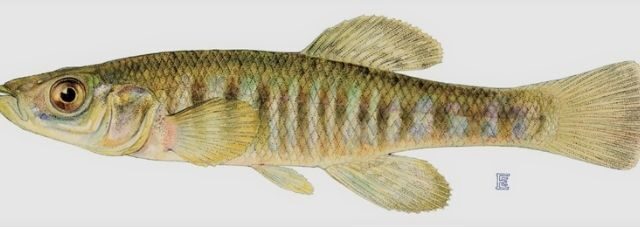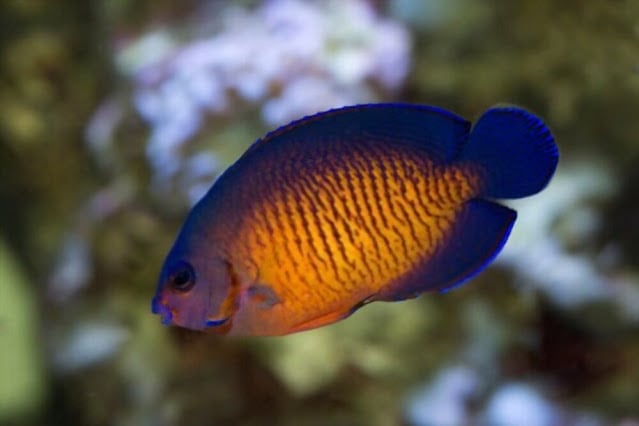Banded Killifish: Size, Habitat, Diet, Aquarium, Tank Mates | Facts
The banded killifish is an amazing freshwater species of killifish, and it is primarily found inhabiting North America’s freshwaters.
Taxonomically, it belongs to the genus Fundulus, and scientifically it’s named Fundulus diaphanus. Well, that’s the debate that has nothing to do with the fishkeepers.
The banded killifish makes up a fantastic aquarium fish that enchants most fishkeeping enthusiasts all over the world.
If you are a beginner, if you can spend time reading and researching their proper care, you can go for them to have in your tank. Otherwise, a year of experience dealing with small freshwater fish is necessary for keeping this fish.
Banded Killifish Size
They are small shoaling fish that ranges in size from 3.93 inches to 5.11 inches long. The females are usually longer than the males.

Being small-sized fish, they mostly travel in schools to avoid predation. In their wild environment, the juveniles travel in a shoal of 8-12 while adults make a shoal of 3-6 individuals.
Although they make up the shoals and only escape from predation, it has nothing to do with their feeding behavior. Hungry individuals get themselves isolated from the shoal to forage for the food as long as they are not threatened again.
Banded Killifish Appearance
Banded killifish are just amazingly patterned vivid fish with overall olive-yellow body color. They have slim and extended bodies with compact heads and small mouths adapted for surface feeding.

Now, what makes them being called Banded killifish is a special feature of their appearance, and that is the presence of the vertical stripes or bands along the flattened sides.
These bands are also an indication to differentiate between males and females. Females have thick and dark bands that are significantly spaced from each other.
However, males are characterized by pale grey bands packed very close together, making the males much brighter than the females. The banded killifish have rayed dorsal and anal fins. Their small and slender bodies make them excellent swimmers.
Banded Killifish Habitat
As we already know that these fishes can live in both freshwater and brackish environments. Still, their major natural distribution is North America’s freshwaters within a wide range of freshwater bodies, as discussed earlier in the intro section.
Okay! So, we already know where these fish are naturally found. This brings us to what their natural habitat exactly has to offer or what area or part of the freshwater bodies the banded killifish prefers.
They prefer quiet areas of the lakes, ponds, and rivers rich in vegetation where the water movements are not much vigorous. Vegetation provides them with shelters to sleep and hideouts in case they are threatened.
The muddy bottom with sand and gravel offer hiding places for juveniles. They are mid-level swimmers, and it’s very seldom that adults will dive into more depth in search of food. That’s it if they are food-deprived.
Banded Killifish Care
Caring for banded killifish means replicating their natural environment in the home aquarium, not only regarding the tank setup but also to what you provide them as their staple food source.
These are hardy, and therefore caring for them is not a big deal. However, proper guidance is necessary, especially if you are new to this hobby.
Caring measures also depend on whether you will keep them in a specific tank or the community tank. If you are a beginner, we recommend you keep a pair alone in the tank.
Ensure you will provide them with enough retreats in the form of submerged vegetation or roots to make them feel at home.
Providing the optimal water conditions is also a critical component of their care, and that is directly dependent on what kind of tank you are putting them in and what tank mates they share the tank with.
They can be housed in both brackish and freshwater tanks and need the tank conditions accordingly.
However, they are primarily freshwater fish, and we also strongly recommend keeping them in a freshwater tank. Weekly water changes of 10% should be done to keep the nitrates level at a minimum. Tabled below are conditions optimally needed for banded killifish.
Temperature & Conditions
| Temperature | Being temperate freshwater fish, they will thrive in any temperature ranging between 70-75 ⁰F. A thermoregulatory action is needed to maintain this range, which a temperature regulator can provide. |
| pH | These fish can survive the pH ranging from 6.5 to 8.5. That’s why they can be found in both freshwaters as well as brackish waters. However, it is best to maintain their tank’s pH at 6.5 to 7 as they are primarily freshwater species. |
| Water hardness | The hardness of water from 120 to 160 ppm is suitable. |
Banded killifish Diet
This section will give an overview of what they eat in the wild and what feeding combinations an aquarist can make to fulfill their nutritional needs.
How Often To Feed Fish & How Much? A Proper Fish Feeding Guide
Banded killifish are primarily carnivorous. In the wild, they prefer to live near dense vegetation where they have plenty to be offered for food.
They feed on many small insects, crustaceans, mollusks, and other tiny similar organisms. The young individuals rely mostly on copepods and larvae, mostly of midge fly and mosquitos.
Now the question that arises is what makes a balanced diet for them in the home aquarium?
The answer to this question may not be as simple as you think. Because there is a little bit of complication, unlike many other tropical and subtropical fishes, the banded killifish won’t accept commercially prepared foods such as flakes.
You might be thinking that this is what a newly acquired fish does. Yes, you are right in your thinking, but the banded and the most killifish species require live foods. You can not shift them to get used to the flakes or other commercial foods for carnivores.
Here is what you can do to make their feeding nutritious without letting the parasitic infections proliferate. The point to be noted here is that the variety is always ideal and adds to the nutritional values.
Feeding Instructions
- Brine shrimp: It serves as a great source of nutrition, especially for the banded killifish food’s vitamin component. Frozen brine shrimps will also work as well as the live ones.
- Tubifex worms: These are an excellent food source for the banded killifish, but they might carry parasitic infections. Rinsing them with cold tap water removes the possible parasites, and they are ready to be fed.
- Black and white worms: Black worms are readily available in the stores, and they are preferred over white worms for their low-fat content.
- Mosquito larvae: They make up the treat for your banded killifish. They tend to overfeed on them. Make sure not to overfeed.
Banded Killifish Ideal Aquarium
Tank Size
An ideal aquarium for the banded killifish provides them with a fair amount of space, shelters, and optimum water conditions. Many of you might be wondering which tank size can be rendered as a suitable size for the banded killifish.
So, 20 gallons is the minimally suitable size for a pair of banded killifish, and the size of the tank varies accordingly for the school or the shoal of the fish.
The tank should be more long than wide. Just make sure that you are not putting the two males together with females or females. We recommend you going with a group of 4, 3 of which should be females.
Tank Setup
As far as the setup is concerned, that has to be a replica of a fish’s natural habitat, which has already been discussed earlier.
Suitable aquarium plants, mainly floating plants, would make the best of the killifish tank. This will make your fish feel at home. You can also add rocks and woods to make crevices for them.
Roots of floating plants can also serve this purpose, but rocks will add a natural look to your killifish tank. For substrate, a mix of sand and gravel will be the perfect fit.
Banded Killifish Tank Mates
As we have already discussed previously, banded killifish are shoaling fish, and putting them in the shoal would be the best thing to do.
Shoal will be great to help this lightweight fish feel stress-free. Otherwise, they are excellent community fish and are peaceful.
They can quickly get along with many friendly and small species in the home aquarium. Some of the best and recommended tank mates for banded killifish are
- Danios
- Tetras
- Small catfish species
- Rainbows
Banded Killifish Breeding
For getting them bred, you need to provide them with suitable breeding conditions in the tank, which are a replica of what they need to breed in their wild home.
In the wild, they live near dense vegetation, which provides them shelter and food, which we have thoroughly discussed earlier, and the leaves and root surfaces of plants provide them places for their eggs to adhere on.
So, what exactly you need to provide the conditions that are suitable for spawning. Ideally, for a shoal of 4 banded killifish, one male individual is enough to have them spawn in your tank.
Two males will never compromise, and they would end up in irreversible fighting. Moreover, these fish’s spawning temperature is 21-23 ⁰C, which you need to maintain essentially. By now, you already know how important plants are to them. This is enough, I guess.
Banded killifish Facts
Some of the facts of banded killifish that can be highlighted are bulleted below.
- They are unique killifish species that are endemic to North America.
- Banded killifish can live in both fresh and brackish water, but freshwater is their primary habitat.
- They inhabit slow-moving waters, especially the peripheries of lakes, ponds, and rivers densely grown with vegetation.
- They prefer muddy bottoms because muddy bottoms are enriched with vegetation.
Banded Killifish vs Mummichog
Mummichog is also a killifish species of North America inhabiting the brackish waters, mostly in the Atlantic coast region. Therefore they are being named Atlantic killifish.
As far as the banded killifish is concerned, it shares many similarities in morphology and behaviors with the Mummichog.
The preferred habitat of banded killifish is freshwater though it can survive the brackish water as well. But the Mummichog is strictly brackish water killifish.
Owing to many similarities, these two killifish species are also known to interbreed in nature and are also seen shoaling together.
These two varieties aren’t thought to be much different locally. Morphologically Mummichogs have very unobtrusive differences from that of banded killifish. The Mummichogs are quite stout and have thick bodies.
Their lower jaw seems to be projected out. They have more thin bars over the olive-green bodies, while the banded killifish vertical bars are more prominent.
FAQs
Banded Killifish Eating Snail
Although the banded killifish are surface feeders, and their upturned mouths are adapted for surface feeding. They are also known to feed in any part of the water.
Sometimes these fish dive deep down the bottom to escape when being threatened. Because of being carnivorous, they would eat anything that would fit their mouths, and snails are no exception.
What do banded killifish eat?
Banded Killifish love to eat many small insects, crustaceans, mollusks, and other tiny similar organisms. The young individuals rely mostly on copepods and larvae, mostly of midge fly and mosquitos.






